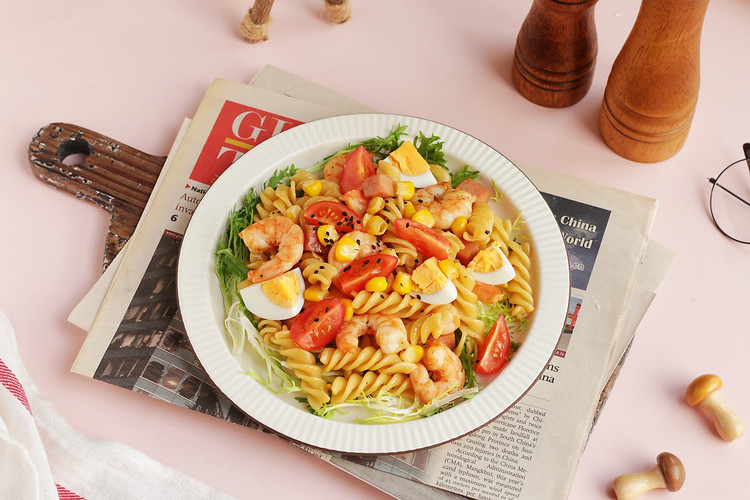Pasta Salad: A Feast for the Senses and a Promise of Health
In the colorful world of cuisine, pasta salad has captured the hearts of many food lovers with its rich flavors and nutritional benefits. From the delightful texture of the pasta to the freshness of the vegetables and the unique flavors of the seasonings, every ingredient exudes a seductive charm.
Nutritional Treasure: The Secrets of Pasta
Pasta is not just a traditional Italian food; it is a nutritional powerhouse. High in carbohydrates, protein, and fiber, pasta provides the body with long-lasting energy. It also contains a variety of vitamins and minerals, such as B vitamins, iron, and zinc, which contribute to numerous health benefits.
Ingredients and Seasonings: The Art of Cooking
The key to making a delicious pasta salad lies in selecting high-quality pasta and fresh ingredients. Fresh pasta should have a springy texture, while vegetables like tomatoes, cucumbers, onions, etc. should be bright in color and free from blemishes. For seasonings, a special pasta salad dressing, olive oil, and lemon juice are essential. You can also add some herbs like basil or mint to give the salad a unique aroma, depending on your preference.
When choosing seasonings, it’s important to opt for natural, low-fat options and avoid heavily processed foods. For example, you can use low-fat salad dressing or lemon juice instead of regular salad dressing. It’s also crucial to control the intake of salt and sugar to maintain the salad’s flavor and nutritional value.
Cooking Techniques: Skills and Patience
Making a pasta salad requires some skill and patience. First, cooking the pasta is crucial. Use high-quality pasta and follow the instructions on the package to achieve the perfect texture. While cooking the pasta, you can add some salt and olive oil to enhance its flavor and texture.
Once the pasta is cooked, it needs to be drained and rinsed with cold water to remove any excess starch and maintain its springy texture. Next comes the preparation of the vegetables. Chop them into appropriate sizes, either julienned or diced, depending on your preference. Add the cooked pasta to the vegetables along with other ingredients like beans or nuts. To add more texture and nutritional value, you can also add some shredded cheese or diced hard-boiled eggs.
Lastly, it’s time to dress the salad. Combine the special pasta salad dressing, olive oil, lemon juice, and any other seasonings you like. Toss everything together until evenly coated. It’s important to be gentle when mixing to avoid breaking the pasta. To add an extra layer of crunch, you can sprinkle some nuts or dried fruits like almonds, walnuts, or raisins on top.
When making the salad, attention should be paid to the freshness of the ingredients and the balance of seasonings to ensure both the flavor and nutritional value are optimized. Additionally, focus should be placed on cooking techniques and timing to maintain the texture and overall quality of the salad.
Enjoyment: Savoring the Flavor or Pairing with Other Dishes
Pasta salads can be enjoyed on their own or paired with other dishes. Due to their rich flavors and diverse textures, they are best enjoyed directly from a fork. You can also add extra seasonings according to your taste buds if desired. As these salads are often served as appetizers or part of a lunch meal, they can be paired with other main courses or soups for a more comprehensive dining experience.
Furthermore, you can experiment with different combinations of pasta salads. For instance, you can mix different shapes of pasta such as spirals, tubes, or noodles. You can also try adding various vegetables and ingredients like lettuce, carrots, bell peppers, etc. Through continuous experimentation and creativity, you can create your own unique pasta salad that suits your taste preferences.
Notes
- Ingredient Freshness: Ensure all ingredients are fresh, especially the pasta and vegetables. Unfresh ingredients can affect both the texture and nutritional value of the salad. Selecting fresh high-quality ingredients is key to making delicious pasta salads.
- Allergies: If you have any allergies to certain ingredients, avoid including them in your pasta salad. Allergic reactions can range from skin irritation to respiratory difficulties and even nausea or vomiting. It’s important to be aware of your allergies and make informed food choices to maintain your health.
- Storage: If you plan to save the salad for later, store it correctly to maintain its freshness. Place the pasta salad in a sealed container and refrigerate it until ready to eat. Make sure to stir thoroughly before serving to ensure all ingredients are evenly distributed. Proper storage techniques will help maintain the freshness and flavor of your salad.

